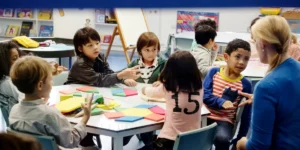Traditional teaching methods, centred around lectures and memorisation, often leave students feeling uninterested. Students learn best when they’re actively involved and excited about what they’re studying.
Have you ever noticed how much more you learn when you’re having fun? That’s the idea behind gamification in education. Instead of just listening to boring lectures and trying to memorise facts, gamification turns learning into a game. Adding challenges, rewards, and storytelling to the mix makes students actively participate in learning.
According to Market Data Forecast, the global gamification education market will experience substantial growth in the coming years. From $1146 million in 2024, the market is projected to reach $5412 billion by 2029, showcasing a remarkable CAGR of 36.4%.
What is Gamification in Education?
This method involves actively involving students in the learning process, fostering immersive experiences similar to navigating through an exciting game. By incorporating interactive gamification, students become active participants, collaborating with peers and applying critical thinking skills within a stimulating game-like environment. This approach goes beyond traditional instruction, creating a dynamic and engaging learning experience for students.
Gamification in education directly addresses the challenge of student engagement by utilising students’ inherent desire for play. This innovative approach creates engaging learning experiences that cater to students of all ages and academic backgrounds. By integrating game elements into education, educators can capture students’ interest and enhance their understanding of academic concepts.
Impact of Gamification in Learning
Incorporating game-like elements, such as points, badges, leaderboards, and challenges, into educational settings can yield numerous benefits. Here’s a breakdown of why gamification works in education:
- Enhances Learning: Gamification in eLearning adds interactive features like role-play and competition, making education engaging and enjoyable. This approach fosters involvement and makes learning fun and informative.
- Boosts Student Engagement: Gamification in class utilizes challenges, achievements, and recognition to enhance engagement. Adding game-like elements makes learning competitive, rewarding, and interactive.
- Improves Focus and Memory: Leveraging interactive games improves focus and strengthens memory retention. Gamified content engages learners, leading to better comprehension and retention
- Teamwork and Collaboration: Encouraging group projects and shared successes helps students develop social skills and foster effective communication, leading to academic and career success.
Considerations for Implementing Gamification in Education
Although incorporating gamification into education can offer numerous benefits, it is crucial to be mindful of the potential challenges that may arise from its overuse. Here are a few key points to keep in mind:
Overemphasising Rewards:
While rewards like points and badges can be effective motivators, it is important not to focus solely on winning. Encouraging a genuine interest in learning should always be the ultimate goal.
Intrinsic Motivation:
Be cautious of how extrinsic rewards may impact students’ intrinsic motivation to learn. A healthy balance is essential to ensure that students remain engaged and eager to explore new knowledge.
Competitive Pressure:
Leaderboards and time-based challenges inadvertently create pressure and stress for some students. Introverted or slower-paced students may feel overwhelmed or demotivated by the pressure to outperform their peers.
By carefully navigating these challenges and striking a balance between motivation and intrinsic interest, gamification can be a powerful tool to enhance the educational experience for students.
Use Cases & Real-World Examples
- Language learning apps like Duolingo and Babbel boost language learning consistency and vocabulary retention through game elements like XP points and badges.
- Platforms like Prodigy and SmartyKids Abacus use role-playing game mechanics and quests to reinforce numeracy skills playfully.
- EdTech gaming platforms such as EdAlive offer personalised fun-loving learning experiences and mastery-based progression in Maths, English, reading, and typing for children aged 4–15.
- Mastory, a gamified and narrative-driven math learning platform, turns algebra and geometry into interactive missions through thrilling sci-fi missions, 3D challenges, and real-world puzzles.
- Teacher-friendly, STEM platform EdShed turns lessons into fun, interactive games loved by students, from spelling and phonics to math and quizzes
- Coding and STEM education platforms like CodeCombat and Scratch help students learn real programming languages like Python and JavaScript by completing missions with code-controlled characters.
- Early Childhood Learning with exciting platforms like ABCmouse and BYJU’S Early gives children a thrilling experience by taking them into a world filled with unlockable content, animated rewards, and progress maps.
Future of Gamification in Education
The future of gamified learning is bursting with exciting potential as technology pushes boundaries while educators strive to captivate students in their learning journey. The integration of Virtual and Augmented Reality technologies, along with the rise of Artificial Intelligence, is paving the way for a thrilling transformation in education. The trend is shifting towards more immersive, student-centred experiences that spark curiosity, foster resilience, and encourage lifelong learning, whether in classrooms, apps, or virtual environments.
Want to make learning fun for your child?
At India Market Entry, we partner with leading global EdTech firms to bring innovative, gamified learning solutions to schools and homes across India. Discover how we can help your child thrive through play-based learning.
–—————————————————————————————————————————-
References:
https://journalgrid.com/view/article/rjahs/12434379
https://www.ecoleglobale.com/blog/gamification-in-education/





